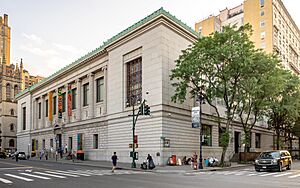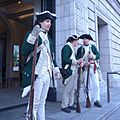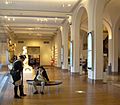New York Historical facts for kids
 |
|
| Established | 1804 |
|---|---|
| Location | New York City, US |
| Type | American history museum and library |
| Architect | York and Sawyer and Walker & Gillette |
The New York Historical is a museum and library in New York City. It is located on the Upper West Side of Manhattan. This special place teaches us about the history of America and New York. It was first called the New-York Historical Society from 1804 until 2024.
The New York Historical was started in 1804. It was New York City's very first museum. It shows exhibits, hosts public events, and supports research. All of these activities help people learn about the history of New York and the United States. The museum has been in its current building since 1908. This building is made of granite and has a classic Roman style. It is a famous landmark in New York City. In 2011, the building was updated. This made it easier for visitors to explore. It also added a fun, interactive museum just for kids.
Louise Mirrer has been the president of the New York Historical since 2004. The museum often focuses on the history of Manhattan. It also explores big topics in American history. For example, in 2005, the museum had a large exhibit called Slavery in New York. This exhibit explored a part of history the museum had not shown before. It even included art from artists who used items from the museum's collections.
The New York Historical has a huge collection of historical items. It also has many American artworks. These items help tell the story of New York and the United States. The museum creates interesting exhibits on many different topics. These include George Washington, Alexander Hamilton, and the history of slavery in New York. Other exhibits have focused on the Hudson River School of art, Abraham Lincoln, and Ulysses S. Grant. The museum also teaches about designers like Clara Driscoll from Tiffany.
The Society also has many programs for schools. They offer resources for teachers. They also have programs for adults who want to keep learning about history.
Contents
Amazing Collections
The New York Historical's museum is the oldest in New York City. It was founded almost 70 years before the Metropolitan Museum of Art. It holds more than 1.6 million pieces of art.
Art and Paintings
The museum has a fantastic collection of Hudson River School paintings. These include important works by Thomas Cole and Frederic Edwin Church. You can also see famous paintings about everyday life and history. These include works by William Sidney Mount and Eastman Johnson. The museum has many American portraits, including paintings by Rembrandt Peale and Gilbert Stuart.
One very special collection is all 435 of John James Audubon's original watercolors. These were made for his famous book, The Birds of America. The museum also has over 800 sculptures. These show the history of American sculpture from early times to today.
The Historical Society also has many paintings and drawings by the marine artist James Bard. It also holds a large part of sculptor Elie Nadelman's American folk art collection. This collection includes furniture, lamps, textiles, glass, and toys.
Historical Objects
The museum's collection of historical items is amazing. You can see George Washington's camp bed from Valley Forge. There is also the desk where Clement Clarke Moore wrote "A Visit from Saint Nicholas". The museum has one of the world's largest collections of Tiffany lamps and glasswork. It also has over 550 American board games from the late 1800s. The New York Historical also owns thousands of photos by photographer Bill Cunningham.
Research Library
The museum's research library has more than three million items. These include books, maps, newspapers, and old letters. It has important papers about the founding of the United States. This includes the first time the phrase ""United States of America"" was written down. The library also has one of the best collections of 18th-century newspapers.
You can find many items about slavery and the American Civil War. This includes Ulysses S. Grant's terms of surrender for Robert E. Lee. The library also has old American stories and poems. It has many items about the history of the circus. You can also find travel stories from early American times to today.
The Society has a website where you can see many images from its collection. In 2015, they put over a thousand old photos by Robert L. Bracklow online.
How It Started
The Historical Society was founded on November 20, 1804. A man named John Pintard worked hard to make it happen. He was also involved in starting New York's first savings bank. He also pushed for free schools. The first meeting included 11 important citizens, like Mayor DeWitt Clinton. They quickly organized the Historical Society.
By 1813, the museum had over 4,000 books. It also had newspapers, maps, and early letters. It had even started collecting oil paintings and engraved portraits.
The Historical Society moved several times in its early years. In 1809, it moved to the Government House. This building was meant for the President of the United States. In 1816, it moved to the New York Institution.
In 1857, the Society moved into its first building built just for its collections. This was on Second Avenue and 11th Street. It stayed there for 50 years. The Historical Society also collected ancient Egyptian and Assyrian art. This collection later moved to the Brooklyn Museum of Art.
The Current Building
Construction for the museum's current home began in 1902. The main part of the building on Central Park West was finished in 1908. It was designed by architects York and Sawyer. In 1938, the building was made larger by architects Walker & Gillette. This expansion is one of the last examples of a grand architectural style called Beaux-Arts architecture in the city. The building was named a landmark in 1966.
Inside the library on the second floor, there are two beautiful stained glass windows. One shows The Arrival of Henry Hudson. The other is called Revocation of the Edict of Nantes. This window honors French religious refugees who came to New York.
Growth and Renewal
The Historical Society's collection kept growing throughout the 1900s. However, it faced money problems in the 1970s and 1980s. This meant they had to limit who could see their collections.
In 1995, the city and state gave grants to help. This allowed the public to access the collections again. Since the late 1990s, the New York Historical has worked hard to improve its building and exhibits. It has also raised money. The museum has increased its budget to offer more public programs.
Recent updates to the Historical Society include new galleries and exhibit spaces. They also have a modern library reading room. There is also a new area for the letters and writings from the Gilder Lehrman Institute of American History. In 2005, the Historical Society received a large grant from the Carnegie Corporation. This was made possible by a donation from New York City mayor Michael Bloomberg.
The museum has created exhibits that connect national history to New York. For example, in 2005, they opened Slavery and the Making of New York, 1600s–1827. This was the first exhibit in New York City to show how important slavery was to the city's economy and history. During colonial times, many households in New York had enslaved people. Much of the city's economy was linked to the South and slavery. The exhibit also showed how African Americans resisted slavery and created their own culture.
Another exhibit was New York Divided: Slavery and the Civil War, 1827–1865. This exhibit explored the city's economy before the Civil War. It also looked at events like the New York City Draft Riots.
Under the leadership of Louise Mirrer, the building had a big renovation. This $65 million project was finished in 2011. It made the museum's resources more open to the public. New windows were added on Central Park West. These windows offer views into the main gallery. The Society also placed life-size bronze statues outside the building. These include Abraham Lincoln and Frederick Douglass. These figures have connections to New York.
After reopening, the Historical Society offered a multimedia experience. It tells major American history themes through stories and people from New York's past. It also has a new, interactive history museum for children.
In 2023, the New York Historical began building the Tang Wing. This new part of the museum will be very large. It will hold collections about LGBTQ+ history. This new wing is planned to open in 2026.
New Name
The Historical Society used to use an older spelling of "New York" with a hyphen. This was common when it was founded in the 1800s. The hyphen helped make the museum's name unique. However, in October 2024, the organization announced a change. It is now known simply as New York Historical.
Images for kids
-
Asher B. Durand, Pastoral Landscape, 1861
-
Corn Planter, Seneca war chief, by F. Bratoli, 1796
See also
- The Course of Empire
- History of New York (state)
- History of New York City
- List of historical societies in New York (state)
- List of museums and cultural institutions in New York City
- List of New York City Designated Landmarks in Manhattan from 59th to 110th Streets










